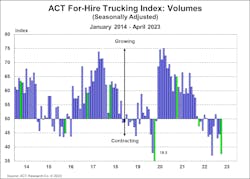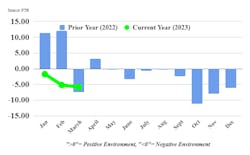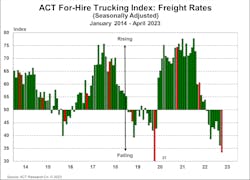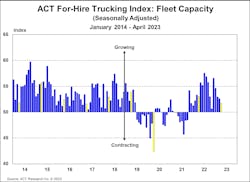Freight volumes, rates, and capacity continue to decline as unfavorable fleet conditions persist, according to lagging trucking industry indexes released before the summer shipping season.
ACT Research’s For-Hire Trucking Volume Index, which is part of a monthly survey of for-hire service providers, weakened more in April to 37.6 from 44.6 in March. The analysts at ACT said that destocking contributed to the softness. However, the 24% year-over-year decline in container imports in the first quarter of 2023 likely represents the worst of the destocking.
“A slowing in destocking would be a positive for volumes,” said Tim Denoyer, VP and senior analyst at ACT. “Inflation, while showing tentative improvement, continues to impact consumer spending power, with retail sales in real terms down 3.6% y/y in April. The slow start produce season may also be a headwind.”
See also: Exodus of fleets reaches historic levels in Q1, U.S. data shows
Also, last week the American Trucking Associations’ advanced seasonally adjusted For-Hire Truck Tonnage Index fell 1.7% from 114.7 in March to 112.7 in April. The year-over-year decrease is 3.4% is the biggest 12-month drop since February 2021.
“While the broader economy continues to surprise and thus far stave off an expected recession, the freight economy is starkly different,” Bob Costello, ATA chief economist, said in a news release. “The goods portion of the economy is soft, and as a result, even contract truck freight is now falling, albeit not nearly as much as the spot market.
Trucking ‘recovery looks fairly shallow’
ACT released its April trucking index report just before the Memorial Day weekend; FTR Transportation Intelligence shared its Trucking Condition Index for March, which fell further into negative territory: decreasing to -5.83 from -5.17 in February.
"The data that drives our forecasting model still suggests that market conditions for trucking companies are at or near bottom, but the recovery looks fairly shallow—certainly compared to recent markets," said Avery Vise, FTR VP of trucking.
The FTR Trucking Condition Index tracks the changes representing five major conditions in the U.S. truck market: freight volumes, freight rates, fleet capacity, fuel prices, and financing costs. The individual metrics are combined into an index indicating the industry's overall health. A positive score represents good, optimistic conditions; a negative score means poor, pessimistic conditions. Readings near zero are consistent with a neutral operating environment, and double-digit readings in either direction suggest significant operating changes are likely.
The ACT For-Hire Trucking Index—broken down into sub-indexes that cover volumes, freight rates, fleet capacity, and more—converts survey responses into diffusion indexes, where the neutral or flat activity level is 50.
See also: When will the freight upturn arrive?
The Pricing Index's slide continued in April, falling 2.7 points to 33.4 from 36.1 in March. This is the second-lowest reading in the index's history, with only April 2020 being lower.
"We believe the cure for low prices is low prices, and since October 2022, the DOT has revoked a net 11,000 operating authorities," Denoyer added. "While the pricing pendulum remains with shippers for now, the next capacity rebalancing has begun. With capacity slowing and set to decline later this year, rate trends should begin to recover as soon as traction on freight volumes is established."
FTR's Vise said there isn't evidence that enough drivers are leaving the market to create a capacity-driven rebound. "Although many very small carriers are failing, so far larger carriers have absorbed that driver capacity," he said. "Freight demand appears just strong enough to keep most drivers employed but not strong enough to keep them fully utilized."
In May, Vise told FleetOwner that of the more than 31,000 fleets that gave up operating authority in the first four months of 2023, nearly 25,000 were one-truck operations. As spot rates skyrocketed during the two years following the pandemic peak, many owner-operators took advantage of favorable conditions.
"In short, there are too many trucks for the amount of freight in the market right now," according to Norita Taylor, spokesperson for the Owner-Operator Independent Drivers Association. "We anticipate seeing more owner-operators lease their trucks onto other carriers until the freight cycle shifts upward again rather than stay under their own authorities."
ACT's Capacity Index ticked down by 0.8 points month-over-month to 51.8 in April, which means it is still growing—but at a slower rate than in 2022. Improvements in equipment production and drivers, due to supply chain improvements and drivers seeking safe harbor in larger fleets, helped grow capacity for the past 18 months, according to ACT.
The Supply-Demand Balance loosened further in April, to 35.8 from 42.0 in March, primarily due to the month-over-month decline in volumes. Still, the slight downtick in capacity also added to the looser reading.
"April marked the 14th consecutive underwater point in the series," ACT's Denoyer said. "For context, in the 2015-16 downcycle, the Supply-Demand Balance was loose for 17 of 19 months. While conditions remain loose, the seeds have been sown for a rebalancing."
About the Author
Josh Fisher
Editor-in-Chief
Editor-in-Chief Josh Fisher has been with FleetOwner since 2017. He covers everything from modern fleet management to operational efficiency, artificial intelligence, autonomous trucking, alternative fuels and powertrains, regulations, and emerging transportation technology. Based in Maryland, he writes the Lane Shift Ahead column about the changing North American transportation landscape.





